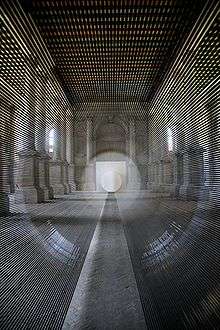Žilvinas Kempinas

Žilvinas Kempinas (born in 1969 in Plungė, Lithuania) is an artist living and working in New York City. He completed an MFA at Hunter College, City University of New York, in 2002, and received a BFA from Vilnius Academy of Art, Lithuania, in 1993. Kempinas is represented in New York City and Paris by Yvon Lambert Gallery, in Vilnius by Vartai Gallery, and in Brazil by Galeria Leme.
Kempinas' first New York shows took place at PS1 Contemporary Art Center in 2003 and Spencer Brownstone Gallery in 2004.[1] The artist has earned international acclaim since his entire second show at Spencer Brownstone – Columns and Bike Messenger – was purchased by The Margulies Collection in 2006 and exhibited during Art Basel Miami Beach that same year. In 2007, Kempinas was featured by Art Review Magazine as one of its 'Future Greats'.[2] In the same year, he was awarded the Calder Prize and a residency at Atelier Calder in Saché, France. In 2008, the artist showed at the San Francisco Museum of Modern Art[3] and, in 2009, in a solo show at the Kunsthalle, Vienna.[4] In 2009, Kempinas represented Lithuania at the Venice Biennale 53rd International Art Exhibition in Venice, Italy.
Works

Kempinas employs nontraditional materials to create active and dynamic exhibits, most commonly as installations. In many of his works, Kempinas utilizes his signature material, unwound magnetic tape. The use of the tape affects the viewer through various senses; visually, aurally and physically.
In his work Double O from 2008, he directed two large electric fans at two loops of magnetic tape causing them to seemingly perpetually fly and dance between the fans.
At the Venice Biennale 2009, Kempinas presented a major new installation entitled Tube.[5] Located in the Lithuanian Pavilion at the Scuola Grande della Misericordia, Tube consisted of magnetic tape strung parallel to the ground creating a large translucent tube or tunnel that viewers can walk through.[6] The work addressed the physical and optical experience of the viewer, the passage of time, and the perception of the body and architecture.[7]
References
- ↑ Kempinas at Spencer Brownstone Gallery
- ↑ Art Review Magazine, "Future Greats: 25 Artists You Need to Know
- ↑ Exhibition at San Francisco Museum of Modern Art, 2008
- ↑ Kempinas 2009 show at Kunsthalle wien
- ↑ Kempinas's Lithuanian Pavilion at the Venice Biennale
- ↑ Tube in Venice
- ↑ E-flux review of the Lithuanian Pavilion at the Venice Biennale 2009
External links
- Interview with the artist, Flash Art Magazine, November-December 2009
- Vernissage video and information on Tube from the Venice Biennale 2009
- Manifesta 2008
- Roberta Smith, review of Zilvinas Kempinas at Spencer Brownstone Gallery, The New York Times, February 10, 2006
- Video of Double O by Zilvinas Kempinas in Art Days
- Videointerview with Zilvinas Kempinas about Dark Room, also discussing video games in contrast to installation art, 2014